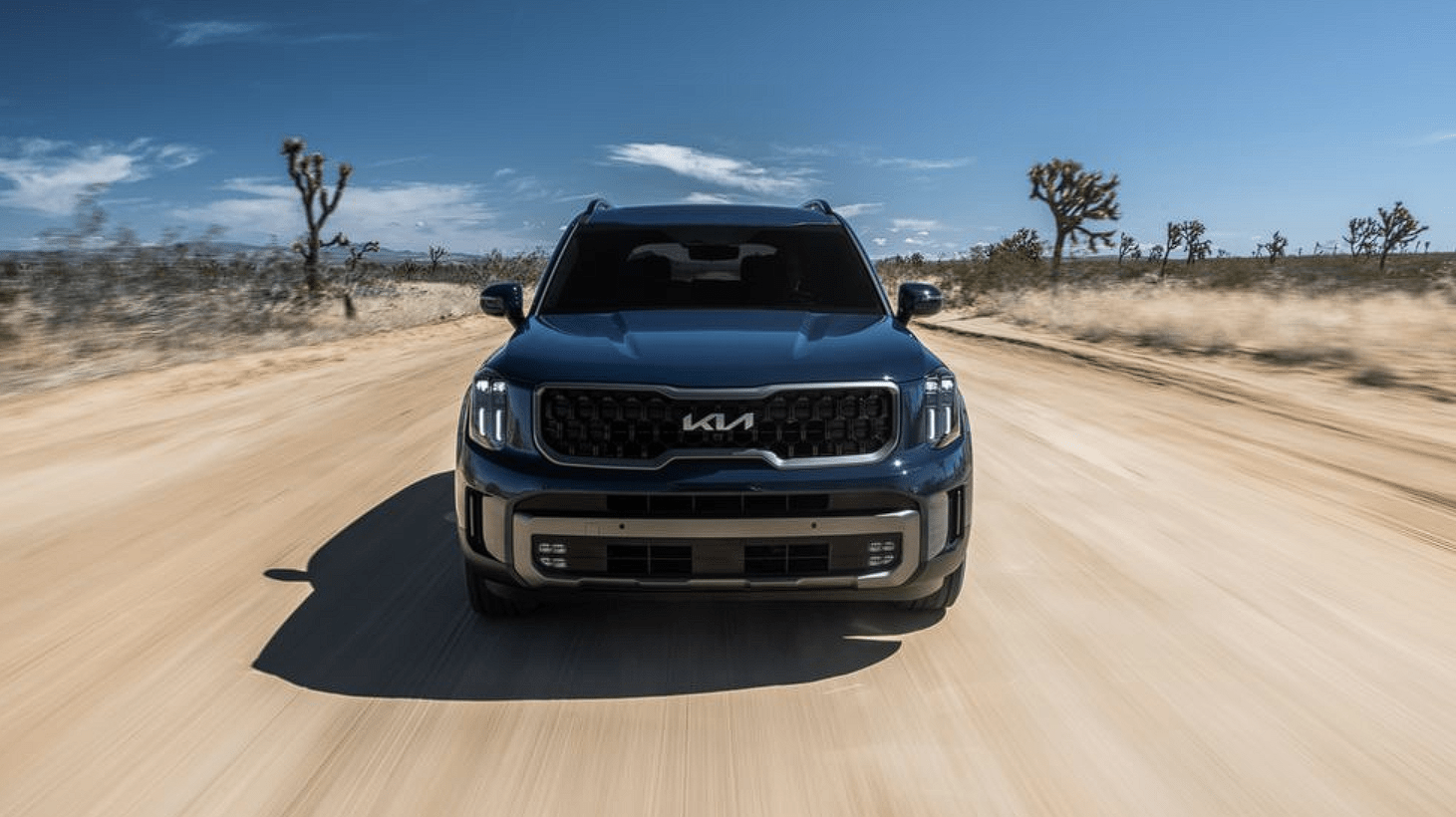Kia Telluride 2023 Idle Stop and Go (ISG) System, Drive Mode Integrated Control System
With its Idle Stop/Go System and Drive Mode Integrated Control System, the 2023 Kia Telluride is a monument to innovation in an industry that is always changing. The Idle Stop/Go System is an example of environmentally friendly engineering because it makes the change from moving to stillness smooth. When the car is not moving, the engine temporarily stops to save fuel and reduce pollution, and it starts again with a touch that you can’t even feel when you need to move. This balances environmental responsibility with practicality. The Drive Mode Integrated Control System, a symphony of performance customization, goes well with this cutting-edge feature. With different driving modes, such as the sporty Sport mode and the eco-friendly Eco mode, the Telluride’s personality can be changed to fit the situation. The throttle response, transmission shift points, and steering feel are all optimized to make the driving experience smooth and adaptable to different surfaces and preferences. By combining these two systems, the 2023 Kia Telluride starts a new age of versatility in cars. It strikes a balance between being good to the environment and having great performance, all in the form of a modern and forward-looking SUV.
2023 Kia Telluride Specs, Price, Features and Mileage (Brochure)
Idle Stop and Go (ISG) system
The Idle Stop and Go (ISG) system reduces fuel consumption by automatically shutting down the engine when the vehicle is at a standstill. (For example: red light, stop sign and traffic jam)
The engine starts automatically as soon as the starting conditions are met.
The ISG is ON whenever the engine is running.
NOTICE
When the engine automatically starts by the ISG system, some warning lights (ABS, ESC, ESC OFF, EPS or Parking brake warning light) may turn on for a few seconds.
This happens because of low battery voltage. It does not mean the system has malfunctioned.
Auto stop
If you depress the brake pedal and the vehicle comes to a stop with the ISG ON, the engine will stop automatically.
Stop the vehicle completely by pressing the brake pedal when the shift lever is in the D (Drive) or N (Neutral) position.
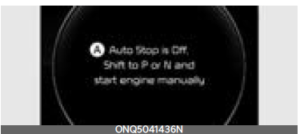
The engine will stop and the green AUTO STOP ( ) indicator on the instrument cluster will appear.

A: Auto Stop is Off. Shift to P or N and start the engine manually
NOTICE
If you open the engine hood in auto-stop mode, the following will happen:
- The ISG system will deactivate (the light on the ISG OFF button will illuminate).
- A message will appear on the LCD display.

A: Press brake pedal for Auto Start
- If you move the transmission lever from N to D (Manual mode) or R without depressing the brake pedal after stopping the engine automatically, the engine does not restart automatically and a warning chime alarms. When this happens, press the brake pedal for auto start.
Auto start
When the engine stops automatically by ISG, the engine will restart if one of the following driver actions.
- Release the brake pedal.
- Move the shift gear to the R (Reverse) position or the Manual mode while depressing the brake pedal.
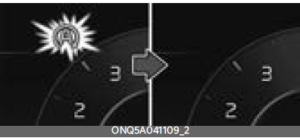
The engine will start and the green AUTO STOP indicator ( ) on the instrument cluster will go out.
The engine will also restart automatically without any driver actions if the following occurs:
- The brake vacuum pressure is low.
- The engine has stopped for about 5 minutes.
- The air conditioning is ON with the fan speed set to the highest position.
- The front defroster is ON.
- The battery is weak.
- The cooling and heating performance of the climate control system is unsatisfactory.
- The vehicle is shifted to P (Park) when Auto Hold is activated.
- The door is opened or the seatbelt is unfastened when Auto Hold is activated.
- The EPB switch is pressed when Auto Hold is activated.
Operating conditions.
The ISG will operate under the following conditions:
- The driver’s seatbelt is fastened.
- The driver’s door and hood are closed.
- The brake vacuum pressure is adequate.
- The battery sensor is activated and the battery is sufficiently charged.
- The outside temperature is not too low or too high.
- The vehicle is driven at a constant speed and stops.
- The climate control system satisfies the conditions.
- The vehicle is sufficiently warmed up.
- The incline is gradual.
- The steering wheel is turned less than 180 degrees and then the vehicle stops.
NOTICE
- If the ISG system does not meet the operation condition, the ISG system is deactivated. The light on the ISG OFF
button and yellow AUTO STOP ( ) indicator on the instrument cluster will appear. - If the light comes on continuously, please check the operation condition.
Deactivating the ISG
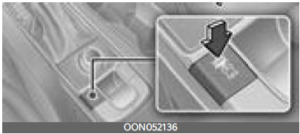
- If you wish to deactivate the ISG, press the ISG OFF button. The light on the ISG OFF button will illuminate.
- If you press the ISG OFF button again, the ISG will be activated and the light on the ISG OFF button will turn off.
ISG malfunction
The ISG may not operate when:
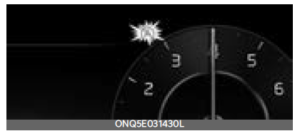
The ISG may not operate when an ISG-related sensor or system error occurs.
The following will happen:
- The yellow AUTO STOP ( ) indicator on the instrument cluster will stay on after blinking for 5 seconds.
- The light on the ISG OFF button will illuminate.
When the engine is in Idle Stop mode, it’s possible to restart the engine without the driver taking any action. Before leaving the car or doing anything in the engine compartment, stop the engine by the ENGINE START/STOP button to the OFF position.
NOTICE
If the AGM battery is reconnected or replaced, ISG system will not operate immediately. If you want to use the ISG system, the battery sensor needs to be calibrated for approximately 4 hours with the ignition off. After calibration, turn the engine on and off 2 or 3 times.
Drive mode integrated control system (FWD)
The drive mode may be selected according to the driver’s preference or road condition.
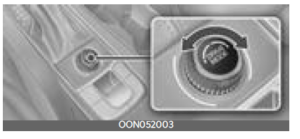
The mode changes whenever the DRIVE MODE knob is turned.
- SMART mode: SMART mode automatically adjusts the driving mode (ECO ↔ COMFORT ↔ SPORT) in accordance with the driver’s driving habits.
- COMFORT mode: COMFORT mode provides soft driving and comfortable riding.
- SPORT mode: SPORT mode provides sporty but firm riding.
- ECO mode: ECO mode improves fuel efficiency for eco-friendly driving.
The driving mode will be set to COM-FORT or ECO mode when the engine is restarted. If it is in COMFORT/SPORT mode, COMFORT mode will be set, when the engine is restarted.
If it is in ECO mode, ECO mode will be set when the engine is restarted.
NOTICE
Drive mode is deactivated when TOW mode is on.
SMART mode
SMART mode selects the proper driving mode among
ECO, COMFORT and SPORT by judging the driver’s driving habits (i.e., mild or dynamic) from the brake pedal or the steering wheel operation.
- Turning the DRIVE MODE knob to activate SMART mode. When SMART mode is activated, the indicator appears on the instrument cluster.
- The vehicle starts in SMART mode
when the engine was turned OFF in SMART mode. - SMART mode automatically controls the vehicle driving, such as gear shift-ing patterns, engine torque, in accordance with the driver’s driving habits.
NOTICE
- When you mildly drive the vehicle in SMART mode, the driving mode changes to ECO mode to improve fuel efficiency. However, the actual fuel efficiency may differ in accordance with your driving situations (i.e., upward/downward slope, vehicle deceleration/acceleration).
- When you dynamically drive the vehicle in SMART mode by abruptly decelerating or sharply curving, the driving mode changes to SPORT mode. How-ever, it may adversely affect fuel economy.
Various driving situations, which you may encounter in SMART mode
- The driving mode automatically changes to ECO mode after a certain period of time, when you gently press the accelerator pedal (Your driving is categorized to be mild.).
- The driving mode automatically changes from SMART ECO mode to SMART COMFORT mode after a certain period of time, when you sharply or repetitively press the accelerator pedal.
- The driving mode automatically changes to SMART COMFORT mode with the same driving patterns, when the vehicle starts to drive on an upward slope of a certain angle. The driving mode automatically returns to SMART ECO mode, when the vehicle enters a leveled road.
- The driving mode automatically changes to SMART SPORT, when you abruptly accelerate the vehicle or repetitively operate the steering wheel (Your driving is categorized to be sporty.). In this mode, your vehicle drives in a lower gear for abrupt accelerating/decelerating and increases the engine brake performance.
- You may still sense the engine brake performance, even when you release the accelerator pedal in SMART SPORT mode. It is because your vehicle remains to be in a lower gear over a certain period of time for next acceleration. Thus, it is a normal driving situation, not indicating any malfunction.
- The driving mode automatically changes to SMART SPORT mode only in harsh driving situations. In most of the normal driving situations, the driving mode sets to be either in SMART ECO mode or in SMART COMFORT mode.
2023 Kia Telluride Specs, Price, Features and Mileage (Brochure)
Limitation of SMART mode
The SMART mode may be limited in the following situations. (The OFF indicator appears in those situations.)
- The driver manually moves the shift lever: It deactivates SMART mode. The vehicle moves, as the driver manually moves the shift lever.
- Cruise control is activated: The Cruise function may deactivate the SMART mode. When a higher system is set by the cruise system, it starts to control vehicle speed and deactivates SMART mode. (SMART mode is not deactivated just by activating the cruise system.)
- The transmission oil temperature is either extremely low or extremely high: The SMART mode can be active in most of the normal driving situations. However, an extremely high/ low transmission oil temperature may temporarily deactivate the SMART mode, because the transmission condition is out of normal operation condition.
SPORT mode
SPORT mode manages the driving dynamics by automatically adjusting the steering effort and the engine and transmission control logic for enhanced driver performance.
- When SPORT mode is selected by turning the DRIVE MODE knob, the SPORT indicator (orange color) will appear.
- Whenever the engine is restarted, the Drive Mode will revert back to COM-FORT mode. If SPORT mode is desired, re-select SPORT mode from the DRIVE MODE knob.
- When SPORT mode is activated:
- The engine rpm will tend to remain raised over a certain length of time even after releasing the accelerator.
- Upshifts are delayed when accelerating.
NOTICE
In SPORT mode, the fuel efficiency may decrease..
ECO mode
ECO
When the Drive Mode is set to ECO mode, the engine and transmission control logic are changed to maximize fuel efficiency.
- When ECO mode is selected by turning the Drive mode knob, the ECO indicator (green color) will appear.
- If the vehicle is set to ECO mode, when the engine is turned OFF and restarted the Drive Mode setting will remain in ECO mode.
NOTICE
Fuel efficiency depends on the driver’s driving habit and road conditions.
When ECO mode is activated:
- The acceleration response may be slightly reduced if the accelerator pedal is engaged moderately.
- The shift pattern of the automatic transmission may change.
Drive mode integrated control system (AWD)
The drive mode may be selected according to the driver’s preference or road condition.
The Drive mode is activated by turning the knob.
The Drive mode changes whenever the knob is turned.
- SMART mode: SMART mode automatically adjusts the driving mode (ECO ↔ COMFORT ↔ SPORT) in accordance with the driver’s driving habits.
- COMFORT mode: COMFORT mode provides soft driving and comfortable riding.
- SPORT mode: SPORT mode provides sporty but firm riding.
- ECO mode: ECO mode improves fuel efficiency for eco-friendly driving.
The driving mode will be set to COM-FORT or ECO mode when the engine is restarted. If it is in COMFORT/SPORT mode, COMFORT mode will be set, when the engine is restarted.
If it is in ECO mode, ECO mode will be set when the engine is restarted.
NOTICE
Drive mode is deactivated when TOW mode is on.
SMART mode
SMART mode selects the proper driving mode among
ECO, COMFORT and SPORT by judging the driver’s driving habits (i.e., mild or dynamic) from the brake pedal or the steering wheel operation.
- Turning the knob to activate SMART mode. When SMART mode is activated, the indicator appears on the instrument cluster.
- The vehicle starts in SMART mode when the engine was turned OFF in SMART mode.
- SMART mode automatically controls the vehicle driving, such as gear shift-ing patterns, and engine torque, in accordance with the driver’s driving habits.
NOTICE
- When you mildly drive the vehicle in SMART mode, the driving mode changes to ECO mode to improve fuel efficiency. However, the actual fuel efficiency may differ in accordance with your driving situations (i.e., upward/downward slope, vehicle deceleration/acceleration).
- When you dynamically drive the vehicle in SMART mode by abruptly decelerating or sharply curving, the driving mode changes to SPORT mode. However, it may adversely affect fuel economy.
Various driving situations, which you may encounter in SMART mode
- The driving mode automatically changes to ECO mode after a certain period of time, when you gently press the accelerator pedal (Your driving is categorized to be mild.).
- The driving mode automatically changes from SMART ECO mode to SMART COMFORT mode after a certain period of time, when you sharply or repetitively press the accelerator pedal.
- The driving mode automatically changes to SMART COMFORT mode with the same driving patterns, when the vehicle starts to drive on an upward slope of a certain angle. The driving mode automatically returns to SMART ECO mode, when the vehicle enters a leveled road.
- The driving mode automatically changes to SMART SPORT, when you abruptly accelerate the vehicle or repetitively operate the steering wheel (Your driving is categorized to be sporty.). In this mode, your vehicle drives in a lower gear for abrupt accelerating/decelerating and increases the engine brake performance.
- You may still sense the engine brake performance, even when you release the accelerator pedal in SMART SPORT mode. It is because your vehicle remains to be in a lower gear over a certain period of time for next acceleration. Thus, it is a normal driving situation, not indicating any malfunction.
- The driving mode automatically changes to SMART SPORT mode only in harsh driving situations. In most of the normal driving situations, the driving mode sets to be either in SMART ECO mode or in SMART COMFORT mode.
Limitation of SMART mode
The SMART mode may be limited in the following situations. (The OFF indicator appears in those situations.)
- The driver manually moves the shift lever: It deactivates SMART mode. The vehicle moves, as the driver manually moves the shift lever
- Smart Cruise Control is activated: The Cruise function may deactivate the SMART mode. When a higher system is set by Smart Cruise Control, it starts to control vehicle speed and deactivates SMART mode. (SMART mode is not deactivated just by activating Smart Cruise Control.)
- The transmission oil temperature is either extremely low or extremely high: The SMART mode can be active in most of the normal driving situations. However, an extremely high/ low transmission oil temperature may temporarily deactivate the SMART mode, because the transmission condition is out of normal operation condition.
SPORT mode
SPORT mode manages the driving dynamics by automatically adjusting the steering effort and the engine and transmission control logic for enhanced driver performance.
- When SPORT mode is selected by turning the knob, the SPORT indicator (orange color) will appear.
- Whenever the engine is restarted, the Drive Mode will revert back to COM-FORT mode. If SPORT mode is desired, re-select SPORT mode from the knob.
- When SPORT mode is activated:
- The engine rpm will tend to remain raised over a certain length of time even after releasing the accelerator.
- Upshifts are delayed when accelerating.
NOTICE
In SPORT mode, the fuel efficiency may decrease.
ECO mode
ECO
When the Drive Mode is set to ECO mode, the engine and transmission control logic are changed to maximize fuel efficiency.
- When ECO mode is selected by turning the knob, the ECO indicator (green color) will appear.
- If the vehicle is set to ECO mode, when the engine is turned OFF and restarted the Drive Mode setting will remain in ECO mode.
NOTICE
Fuel efficiency depends on the driver’s driving habit and road conditions.
When ECO mode is activated:
- The acceleration response may be slightly reduced if the accelerator pedal is engaged moderately.
- The shift pattern of the automatic transmission may change.
The above situations are normal conditions when ECO mode is activated to improve fuel efficiency.
Limitation of ECO mode operation:
If the following conditions occur while ECO mode is operating, the system operation is limited even though there is no change in the ECO indicator. - When driving the vehicle with the automatic transmission gear shift lever in Manual mode.
The system will be limited according to the shift location.
FAQ
The Idle Stop/Go System is a feature that automatically shuts off the engine when the vehicle comes to a complete stop, such as at a traffic light, to save fuel and reduce emissions. It restarts the engine when you release the brake pedal.
When you come to a stop and the conditions are met (such as the engine being warmed up), the system will temporarily turn off the engine. When you release the brake pedal or press the accelerator, the engine restarts quickly and smoothly.
In most cases, the 2023 Telluride allows you to disable the Idle Stop/Go System temporarily through a button or menu option if you prefer to keep the engine running at idle.
Yes, the Idle Stop/Go System can help improve fuel efficiency by reducing unnecessary idling when the vehicle is stopped.
Some models of the 2023 Telluride may allow customization of the Idle Stop/Go System settings, allowing you to tailor it to your preferences.
The Drive Mode Integrated Control System is a feature that allows you to select different driving modes to adjust the vehicle’s performance characteristics, including throttle response, transmission shift points, and steering feel.
The 2023 Telluride typically offers several drive modes, including modes like Normal, Sport, Eco, and Snow, each optimizing the vehicle’s performance for different driving conditions and preferences.
Yes, in most cases, you can switch between drive modes while driving to adapt to changing road conditions and driving styles.
Yes, selecting different drive modes can impact how power is distributed among the wheels in an AWD-equipped Telluride, optimizing traction and stability.
Some models of the 2023 Telluride may offer customizable drive mode settings, allowing you to fine-tune the vehicle’s performance to your preferences.
The Sport mode typically adjusts throttle response, transmission shift points, and steering feel to provide a more dynamic driving experience with quicker acceleration and sharper handling.
The Eco mode is designed to maximize fuel efficiency by optimizing engine and transmission settings for more conservative fuel consumption.
Yes, the Snow mode adjusts power distribution and other settings to enhance traction on snow or ice, providing better control in winter driving conditions.
Yes, the Drive Mode Integrated Control System settings are typically accessible through the vehicle’s infotainment touchscreen or control panel.
The Drive Mode Integrated Control System allows you to tailor the Telluride’s performance to your specific driving needs and preferences, whether you’re looking for a sportier ride, improved fuel efficiency, or better traction in challenging conditions, ensuring a more enjoyable and adaptable driving experience.
Useful Link
View Full User Guide: Kia Telluride 2023 User Guide
Download Manuals: https://owners.kia.com/content/owners/en/manuals.html
2023 Kia Telluride Specs, Price, Features and Mileage (Brochure)

